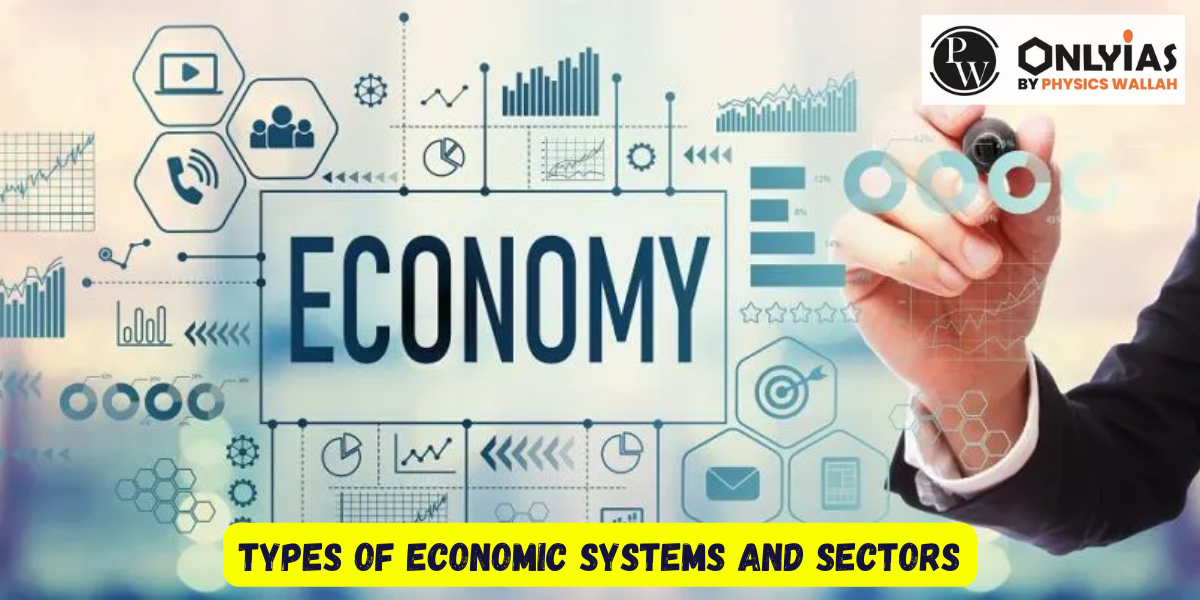![]() Madhavi Gaur
Madhavi Gaur
![]() September 05, 2023 01:18
September 05, 2023 01:18
![]() 5466
5466
![]() 0
0

Types of Economy: From market economies to command economies, and everything in between, the landscape of economic systems shapes the livelihoods of billions around the globe. Moreover, we will unravel the fundamental sectors that comprise these economies, from agriculture and manufacturing to services and technology. Join us as we navigate through the foundational concepts that underpin the functioning of societies and influence their growth, development, and prosperity.

Economy encompasses the intricate web of processes involving the creation, distribution, and utilization of goods and services within a specific nation or region. It embodies the intricate dance between individuals, enterprises, and institutions as they engage in trade and the interchange of commodities and services. The study of economy can be observed through both macroeconomic and microeconomic lenses, each shedding light on different facets of this dynamic realm.
At its core, the economy embodies a rich tapestry of activities ranging from production and trade to financial operations and consumption patterns. Enterprises, acting as key players, undertake the production of goods and services, employing resources like capital, labor, technology, and natural assets. Markets, acting as conduits, facilitate the exchange of commodities and services, with prices established through mutual agreement between buyers and sellers. Ultimately, households and businesses play a crucial role as consumers, utilizing the products and services generated by the economy to satisfy their various needs and desires.
The economy stands as a canvas upon which a multitude of factors wield their influence. Government policies, both domestic and international economic conditions, technological innovations, and sociocultural dynamics are some of the elements that shape its trajectory. By unraveling the complexities of the economy, policymakers, businesses, investors, and individuals can make informed decisions that impact economic strategies, investment choices, and consumption patterns.
In essence, the study of the economy is not merely an academic pursuit, but a practical endeavor that empowers stakeholders to navigate the intricate landscape of production, distribution, and consumption. It offers a panoramic view of the interactions, decisions, and forces that shape the economic destiny of a nation or region.
Within the realm of economics, a diverse array of economic systems exists, each distinguished by its unique attributes and merits. Among the prevalent categories of economies are the Traditional Economy, Command Economy, Market Economy, Mixed Economy, Green Economy, Sharing Economy, Digital Economy, Developed Economy, Emerging Economy, Socialist Economy, Subsistence Economy, Circular Economy, and Capitalist Economy.

Economic systems play a fundamental role in shaping the way societies produce, distribute, and consume goods and services. Across the globe, a diverse range of economic systems exists, each reflecting distinct principles, ideologies, and approaches to resource allocation and wealth generation.
Understanding the various types of economic systems is essential for comprehending how economies function, the roles of governments and markets, and the implications for individuals and societies at large. From traditional practices rooted in cultural norms to modern digitally-driven economies, the array of economic systems provides a rich tapestry of approaches that contribute to the global economic landscape.
List of Types of Economic Systems |
|
|---|---|
| Types of Economy | Description |
| Traditional Economy | Relies on traditions, customs, and beliefs to allocate resources and make economic decisions. |
| Command Economy | Centralized government controls production, distribution, and allocation of goods and services. |
| Market Economy | Decisions about production, distribution, and pricing are determined by supply and demand in a free market. |
| Mixed Economy | Combines elements of both market and command economies, with government and private sectors coexisting. |
| Green Economy | Focuses on sustainability and environmental conservation, promoting eco-friendly practices and industries. |
| Sharing Economy | Individuals share resources, services, or products through platforms like peer-to-peer sharing and collaborative consumption. |
| Digital Economy | Emphasizes digital technologies, online commerce, and data-driven activities in economic processes. |
| Developed Economy | High income, advanced infrastructure, and diverse industries characterize these well-established economies. |
| Emerging Economy | Rapidly growing economies transitioning from agrarian to industrial, often with increasing foreign investments. |
| Socialist Economy | Government owns and controls major industries, with redistribution of wealth and resources for public welfare. |
| Subsistence Economy | Focuses on producing enough to meet immediate needs, often in rural or undeveloped regions. |
| Circular Economy | Aims to reduce waste and promote recycling by designing products and systems for long-term use and reusability. |
| Capitalist Economy | Private ownership and competitive markets drive production, distribution, and pricing of goods and services. |
The traditional economic system harks back to established patterns of goods, services, and labor. It thrives on a significant reliance on individuals and lacks substantial division of labor or specialization. Essentially, it represents the most primitive of the four economic types.
This system endures in various corners of the world, particularly in rural settings of developing nations. It predominantly revolves around traditional livelihoods such as agriculture, prevalent in second and third world countries.
Resource scarcity characterizes communities adhering to traditional economic systems, stemming either from natural limitations or restricted access. Consequently, generating a surplus is challenging in this system, setting it apart from the other three. Despite its rudimentary nature, the traditional economic system showcases remarkable sustainability and minimal wastage, a feature not as pronounced in its counterparts.
In a command economic system, a central authority, often the government, assumes dominance over a substantial portion of the economic framework. This system, also termed a planned system, aligns with communist societies, where governmental intervention dictates production decisions.
Resource abundance tends to steer economies towards a command structure, wherein the government exercises control, particularly over valuable resources like gold or oil. The populace governs less critical sectors like agriculture.
In theory, the command system functions optimally when the central authority prioritizes the collective welfare. However, this ideal seldom translates to reality. Command economies exhibit rigidity compared to other systems, lagging in adapting to changes due to centralized control. This renders them vulnerable to economic upheavals or emergent situations, challenging their capacity for swift adjustments.
Market economic systems rest upon the principles of unbridled markets, with minimal governmental interference. Here, resources remain mostly outside government control, and essential economic facets operate within the dynamics of supply and demand, regulated by the populace.
While primarily theoretical, pure market systems rarely exist due to some level of central authority intervention. Governments often enact laws governing fair trade and monopolies, constraining the idealized market setup.
In theory, market economies foster substantial growth, arguably at its zenith under this system. Yet, its primary drawback is the potential accumulation of significant economic power among private entities, particularly those commanding invaluable resources. This results in an uneven resource distribution, favoring economic powerhouses.
Mixed systems harmonize market and command economic attributes, earning the moniker “dual systems.” In certain contexts, this term signifies a market system subject to stringent regulatory control.
Many developed nations in the western hemisphere embrace mixed systems. Here, most industries operate privately, while public services and other sectors fall within governmental purview.
A global norm, mixed economies strive to meld the best of market and command characteristics. Practical implementation, however, entails a delicate balance between free markets and government oversight. Often, governments exert more control than necessary, posing an ongoing challenge in achieving equilibrium.
India’s economy is often characterized as a mixed economy, encompassing elements from both market and command economic systems. Below is a comprehensive overview of the diverse types of economy present in India, accompanied by illustrative examples:
Types of Economic Systems in India |
|||
|---|---|---|---|
| S. No | Types of Economic Systems | Examples | Description |
| 1. | Capitalist Economy | HDFC Bank, Infosys, Maruti Suzuki | An economic system where goods and services are produced, distributed, and priced based on market forces of supply and demand, with private entities owning and operating the majority of industries and sectors. |
| 2. | Market Economy | Flipkart, Ola, Paytm, Tata Motors, Reliance Industries | An economic framework where goods and services are created, distributed, and valued according to the influences of supply and demand in the market. |
| 3. | Mixed Economy | State Bank of India, Indian Railways | A hybrid economic system that amalgamates attributes of both market and command economies. The government maintains ownership and operation of crucial industries and sectors while permitting market dynamics to flourish. |
| 4. | Socialist Economy | Mahatma Gandhi National Rural Employment Guarantee Act, Public Distribution System | A socioeconomic system in which the government oversees the production and allocation of goods and services, aiming to achieve social welfare and equality. |
| 5. | Traditional Economy | Agriculture, Handicrafts | Economic activities are rooted in traditional customs, beliefs, and practices, forming the foundation of this system. |
The exploration of various types of economy holds significant importance within the UPSC syllabus, forming a pivotal dimension of India’s economic landscape and governance framework. Gaining an in-depth grasp of diverse economic systems – encompassing traditional, market, mixed, socialist, and capitalist economies – assumes paramount significance for aspirants undertaking UPSC examinations. This comprehension equips them with a holistic perspective on India’s economic policies and structures.
Furthermore, for those aspiring to excel in UPSC exams, the availability of high-quality study resources, coaching, and practice examinations is of utmost importance. Esteemed UPSC online coaching platforms like PWOnlyIAS extend comprehensive courses and meticulously crafted study materials that encompass a wide spectrum of subjects, including distinct types of economies. These platforms also offer invaluable UPSC mock tests, invaluable tools aiding aspirants in their preparation journey for the UPSC examinations.
7 Best Books for Indian Economy for UPSC 2024
Economic Setup of India: Projected to be 3rd in Global Economy by FY28 – SBI Ecowrap
<div class="new-fform">
</div>

Latest Comments